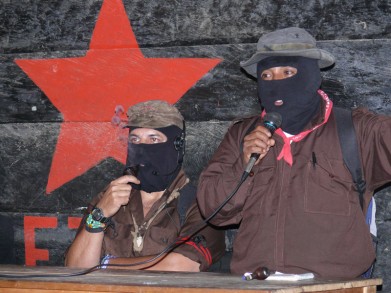Moisés, Another EZLN Subcomandante
By: Gloria Muñoz Ramírez
Visionary, military strategist, and organizer of the people, these are some of the characteristics of the new Subcomandante of the Zapatista National Liberation Army (EZLN, its initials in Spanish). Known as Major Moisés in early January 1994, he would move to the position of Lieutenant Colonel in 2003. Today, Subcomandante Marcos, Zapatista military leader and spokesperson, introduced him as the new Subcomandante of the insurgent forces.
“We want to introduce you to one of the many “he’s” that we are, our compañero Subcomandante Insurgente Moisés. He guards our door and he also speaks using the words of all of us. We ask you to listen to him, which is, to look at him and so to look at ourselves,” said Subcomandante Marcos during the public announcement of the new appointment.
Moisés is one of the most well known insurgent commanders in the public life of the EZLN. On 16th February 1994, during the handing over of General Absalón Castellanos, the EZLN’s prisoner of war, he was seen for the first time heading what would be the first of the Zapatista public events after the beginning of the war: an act full of symbolism that was finalized with the exchange of the former Governor of Chiapas, known for his ruthless actions, for hundreds of Zapatistas taken prisoner during the first days of the war. The act was taken advantage of to make the ethical presentation of a movement that sentenced him to bear the forgiveness of those he had humiliated, imprisoned and murdered.
“I have come to hand over the prisoner of war, who is General Absalón Castellanos Dominguez. In a few words: The People’s Army, the Zapatista National Liberation Army, has complied as between warriors and rivals. Military honor has value, as the only bridge. Only real men use it. Those who fight with honor, speak with honor.” These were the first words which were heard from the then Major Moisés, in one of the most emotional events of these 19 years of struggle: the first presentation of the Zapatista support bases in Guadalupe Tepeyac.
Subcomandante Moisés came to the Zapatista organization, as he himself has said, in 1983. Of Tzeltal origin, he was sent to “the city” as part of his preparation and there, in a clandestine house, he met Subcomandante Pedro, who later became his leader, and for whom he would become his right arm. Afterwards, he would be very close to Subcomandante Marcos. Moisés was one of the people who opened up the Tojolabal canyon areas of Las Margaritas; he visited village-by- village, family by family, explaining the reasons for the struggle.
Of short stature, and with an enormous heart and political vision, always wearing his black military hat, with a sense of humor which does honor to the depth of the Tzeltal people, it fell to Moisés to withdraw at the side of Marcos during the government’s betrayal of 9th February 1995; this is why much of the literature produced during that period portrays them together, with him as squire.
Witness to one of the last meetings between Subcomandante Marcos and Subcomandante Pedro, his second in command, Moisés describes how the two commanders argued because both of them wanted to go to war. But both said the other had to stay behind, because if one of them fell the other would have to carry on. Both of them went out, the first one to the taking of San Cristobal de las Casas, and the second to Las Margaritas, where he (Pedro) was killed in combat the same morning. At that time, with uncontrolled insurgent troops, the now new Subcomandante assumed the command and control of the operation in the region.
Later on, after the handing over of General Absalón, the dialogues in the Cathedral, and the opening up of the territory in rebellion to civil society and the media, the vast majority of the Zapatista public activities moved to the Tojolabal canyon area, where Subcomandante Marcos appeared regularly alongside the then Major Moisés and Comandante Tacho, among other civilian and military leaders in the region.
During those first months and years, in addition to his work within the organization, Moisés appeared as the middleman speaking with a good part of national and international civil society; he provided media interviews explaining the beginnings of the Zapatista struggle, the content and motives of their peaceful and political initiatives, and, later, the functioning of the Good Government Juntas, of which he was the promoter of their first forerunner, the Association of Autonomous Municipalities.
In 2005, with the release of the Sixth Declaration of the Lacandón Jungle, he was appointed by the General Command to be in charge of international affairs, in a committee known as “La Intergaláctica.” During that period, while Delegate Zero was traveling the country with the Other Campaign, the then Lieutenant Colonel received visits from other countries and sent greetings to international meetings.
Known for his patience, openness and willingness, on the occasion of the 20th birthday of the EZLN, he said: “It is our way to first do the practice, then the theory. And so, after the betrayal, when the political parties and the government rejected the recognition of indigenous peoples, we began to look at what we were going to do.”
Without a doubt Subcomandante Moisés can, with pride, subscribe to his own words: “I think if you have to be a revolutionary you have to be one right until the end, because not reaching its consequences or abandoning people and those things, well it is not right. We the fighters, our other brothers from other states, from this same country Mexico and the world, we need to assume the responsibility….”. And he does.
Originally Published in Spanish by Desinformemonos
En español: http://desinformemonos.org/2013/02/moises-otro-subcomandante-en-el-ezln/
Translated by Nélida Montes de Oca
Editing: Chiapas Support Committee
